
A Guide to Diagnosing and Building Capability in Leaders
- Our Subject Matter Experts
- April 28, 2025
- 1:34 pm
- No Comments

Introduction
In today’s fast-paced and competitive business environment, effective leadership is critical. Organizations thrive when they have strong leaders who can inspire, motivate, and guide their teams toward success. However, identifying and developing these leaders is not always easy. It requires a thorough understanding of their strengths, weaknesses, and potential. This guide will outline the key steps in identifying and developing leadership capabilities, providing a simple plan for organizations to cultivate their leadership talent.
Leadership capability varies according to the role and context. Leaders’ skills and behaviors must vary depending on the situation. As a result, it is critical to accurately assess and develop leadership capabilities in strategic ways. This ensures that leaders are prepared to handle the unique challenges of their positions and contribute effectively to their organization’s objectives.
Businesses can foster growth, innovation, and long-term success by building a solid leadership pipeline through the application of a methodical approach. This blog will help you identify and improve your leadership abilities so that your company can prosper.
Diagnosing and Building Capability in Leaders
1. Assess Current Leadership Skills
The first and foremost step in diagnosing and building capacity in leaders is to evaluate the current skills and competencies of potential leaders. This can be accomplished through a variety of methods, including 360-degree feedback, self-assessment, and performance reviews. These tools offer a comprehensive assessment of a leader’s strengths and areas for improvement. To obtain a balanced perspective, gather feedback from a variety of sources, including peers, subordinates, and supervisors.2. Identify Key Leadership Competencies
The next stage is to determine the essential competencies needed for effective leadership in the particular context of the organization, after the current skill set has been evaluated. Strategic thinking, emotional intelligence, decision-making, communication, and the capacity to uplift and motivate others are a few examples of these competencies. Comprehending the particular competencies required facilitates the creation of tailored development plans for every leader.3. Create Individual Development Plans
With a clear understanding of the necessary competencies, organizations can create individual development plans for their leaders. These plans should outline specific goals, learning activities, and timelines for achieving them. Development activities may include formal training programs, mentoring, coaching, and on-the-job learning experiences. The focus should be on continuous improvement and adapting to changing business needs.4. Implement Development Programs
Implementing the development plans requires a structured approach. Formal training programs can provide leaders with the theoretical knowledge and skills they need. Mentoring and coaching offer personalized guidance and support, helping leaders apply what they have learned in real-world situations. Additionally, on-the-job learning experiences, such as leading projects or teams, allow leaders to practice and refine their skills.5.Monitor Progress and Provide Feedback
Continuous monitoring and feedback are essential for effective leadership development. Regular check-ins and progress reviews help ensure that leaders are on track to meet their development goals. Constructive feedback provides leaders with insights into their performance and areas for improvement. It is important to celebrate successes and address challenges promptly to keep leaders motivated and engaged in their development journey.
6.Evaluate and Adjust Development Plans
The final step is to evaluate the effectiveness of the development plans and make necessary adjustments. This involves reviewing the outcomes of the development activities and assessing whether the leaders have acquired the desired competencies. Feedback from the leaders themselves, as well as from their teams, can provide valuable insights into the impact of the development efforts. Based on this evaluation, organizations can refine their development strategies to better meet the needs of their leaders.Bottom Line
Building leadership capabilities is an ongoing and dynamic process that necessitates a strategic approach. Organizations can ensure that their leaders are well-equipped to drive success by accurately assessing their current skills. Implementing structured development programs, providing continuous feedback, and regularly evaluating progress are all critical steps in this journey.
Investing in leadership development not only improves individual leaders’ capabilities, but also contributes to the organization’s overall success. Effective leaders inspire and motivate their teams, drive innovation, and confidently face challenges. Organizations can cultivate a strong leadership pipeline that will support their long-term goals with ease.
Read More – The Role of Psychometric Testing in Team Building






